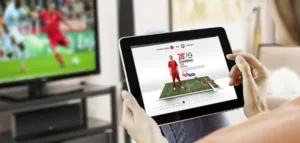Market researcher Accenture has bad news for the TV market. In a new research report titled ‘Digital Video and the Connected Consumer’, TV was the only product category to experience double-digit usage declines across different media types, worldwide, among viewers of ‘nearly all’ ages. Consumers are instead turning to PCs and mobiles to consume video content.
Anytime, anywhere video consumption has become mainstream. Long-form video viewing has fallen 13% worldwide over the past year, and by 11% in the USA. Sports viewership on TV screens also fell, by 10% globally and 9% in the USA.
Young people (14 – 17 years, aka millenials) abandoned the TV at a rate of 33% for films and TV shows and 26% for sport. The decline was less pronounced as viewers grew older: 14% (films/programmes) and 12% (sport) for 18 – 34-year-olds; 11% and 9% for 35 – 54-year-olds; and 6% and 1% for those aged 55+.
An improved streaming experience and longer battery lives have prompted the rise of mobile TV viewing, says Accenture’s global broadcast industry lead, Gavin Mann. He added, “The second screen viewing experience is where the content creators, broadcasters and programmers will succeed or fail”.
37% of consumers were found to own multiple devices (some combination of smartphones, laptops/desktops and tablets). 61% of consumers planning to buy a TV will buy a smart model and 25% will buy an UltraHD set – up 7% YoY.
The quality of online streaming services is becoming a concern as more and more people use them. Accenture’s data shows that 89% of consumers watch long-form content on connected devices – many of whom say that there are issues with the experience. The primary complaint of 51% of these respondents was poor internet service. Other issues were too much advertising placement (42%); buffering (33%); and loss of sound or distortion during play (32%). If paid services included more content variety, less advertising and better quality, respondents said that they would sign up to them.
Accenture’s survey showed that traditional TV broadcasters have an advantage over new market entrants. Respondents were much more likely to prefer services from these companies, even against pay-TV or VoD from brands like Apple, Netflix and Google. “New entrants, regardless of their brand, will have to prove their service quality to consumers to capture significant market share”, said Mann.
Second-screen use is wide-spread; 87% of consumers said that they use more than one device at once. The smartphone was the most common companion device globally (57%), particularly among millenials (74%). However, a laptop or desktop was more common in North America (59%, versus 42% for smartphones).

